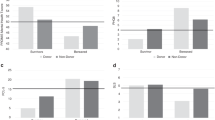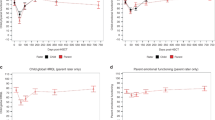Abstract
The primary purpose of this research was to develop and evaluate the efficacy and feasibility of a brief, cost-effective family-focused intervention to promote adaptive coping and quality of life throughout a parent’s bone marrow transplantation (BMT). Targeted outcomes were cohesion, decreased use of avoidance coping, open communication and effective management of emotional distress. Participants included an intervention group of 31 families and 29 families in a control group who received usual care. Each family included the BMT recipient, a partner/caregiver and children 10–18 years old. The intervention included two dyadic sessions for the BMT recipient and the partner/caregiver, one individual session for the caregiver and two digital video discs (DVDs) for children. Statistical analyses indicated that the intervention had a positive impact on at least one aspect of the adaptation of each family member. Caregivers reported the most distress but benefitted least from the intervention, whereas recipients and children reported improvement in distress. Ratings of satisfaction/acceptability were high, with 97% responding that they would recommend the intervention to others. Plans for future research include increased intervention intensity for the caregiver, a larger more diverse sample and implementation over an extended period post BMT.
This is a preview of subscription content, access via your institution
Access options
Subscribe to this journal
Receive 12 print issues and online access
$259.00 per year
only $21.58 per issue
Buy this article
- Purchase on Springer Link
- Instant access to full article PDF
Prices may be subject to local taxes which are calculated during checkout

Similar content being viewed by others
References
Gooley TA, Chien JW, Pergam SA, Hingorani S, Sorror ML, Boeckh M et al. Reduced mortality after allogeneic hematopoietic-cell transplantation. N Engl J Med 2010; 363: 2091–2101.
Fife B, Fausel C . Hematopoietic Dycrasias and Stem Cell/Bone Marrow Transplantation, 2nd edn. Oxford University Press: Oxford, UK, 2010.
Keogh F, O'Riordan J, McNamara C, Duggan C, McCann SR . Psychosocial adaptation of patients and families following bone marrow transplantation: a prospective, longitudinal study. Bone Marrow Transplant 1998; 22: 905–911.
Bishop MM, Beaumont JL, Hahn EA, Cella D, Andrykowski MA, Brady MJ et al. Late effects of cancer and hematopoietic stem-cell transplantation on spouses or partners compared with survivors and survivor-matched controls. J Clin Oncol 2007; 25: 1403–1411.
Mosher CE, Redd WH, Rini CM, Burkhalter JE, DuHamel KN . Physical, psychological, and social sequelae following hematopoietic stem cell transplantation: a review of the literature. Psychooncology 2009; 18: 113–127.
Langer S, Abrams J, Syrjala K . Caregiver and patient marital satisfaction and affect following hematopoietic stem cell transplantation: a prospective, longitudinal investigation. Psychooncology 2003; 12: 239–253.
Fife BL, Monahan PO, Abonour R, Wood LL, Stump TE . Adaptation of family caregivers during the acute phase of adult BMT. Bone Marrow Transplant 2009; 43: 959–966.
Von Ah D, Spath M, Nielsen A, Fife B . The caregiver's role across the bone marrow transplantation trajectory. Cancer Nurs 2016; 39: E12–E19.
Fife BL, Weaver MT, Cook WL, Stump TT . Partner interdependence and coping with life-threatening illness: the impact on dyadic adjustment. J Fam Psychol 2013; 27: 702–711.
Spath ML, Fife BL, Monahan PO, Decker CL, Austin JK, Abonour R et al. Children's emotional adaptation to parental BMT. Bone Marrow Transplant 2013; 48: 135–140.
Cox MJ, Paley B . Families as systems. Annu Rev Psychol 1997; 48: 243–267.
Watson D, Clark LA. (1994). The PANAS-X: Manual for the Positive and Negative Affect Schedule-Expanded Form. Ames, The University of Iowa: Iowa City, Iowa, USA, 1988.
Landgraf J, Abetz L, Ware J . Child Health Questionnaire (CHQ): A User's Manual. The Health Institute, New England Medical Center: Boston, MA, USA, 1996.
Lazarus R, Folkman S . Stress, Appraisal, and Coping. Springer Publishing Company: New York, NY, USA, 1984.
Connor-Smith JK, Compas BE, Wadsworth ME, Thomsen AH, Saltzman H . Responses to stress in adolescence: measurement of coping and involuntary stress responses. J Consult Clin Psychol 2000; 68: 976–992.
Moos R, Moos B . Family Environment Scale (FES). CPP/Consulting Psychologists Press: Palo Alto, CA, USA, 1981.
Cowan P, Hetherington EM . Family Transitions. Erlbaum: Hillsdale, NJ, USA, 1991.
Rosenbaum P, Rubin D . Reducing bias in observational studies using subclassification on the propensity score. J Am Stat Assoc 1984; 79: 516–524.
Cohen J . Statistical Power Analysis for the Behavioral Sciences, 2nd edn. Routledg: London, UK, 2013.
Spanier G . Measuring dyadic adjustment: new scales for assessing the quality of marriage and similar dyads. J Marriage Fam 1976; 38: 15–28.
Hamilton BK, Law AD, Rybicki L, Abounader D, Dabney J, Dean R et al. Prognostic significance of pre-transplant quality of life in allogeneic hematopoietic cell transplantation recipients. Bone Marrow Transplant 2015; 50: 1235–1240.
Harris J, Bowen DJ, Badr H, Hannon P, Hay J, Regan Sterba K . Family communication during the cancer experience. J Health Commun 2009; 14 (Suppl 1): 76–84.
Acknowledgements
We thank the participating families for sharing their experiences with us. We thank the BMT Programs of Jewish Hospital of Cincinnati and St Francis Medical Center of Indianapolis for the participation of their BMT recipients and families. We also thank Lyn Sontag and Vickie Alfrey respectively for their coordination with this study. We also thank our colleagues Linda Brown and Daniel Pesut for the roles they assumed in creation of the DVDs. Grants from the American Cancer Society (RSGPB-05-012-01-CPPB) and NIH (R21NR01223) supported this research. The content in this paper is solely the responsibility of the authors and does not necessarily represent the official views of the funding agencies.
Author information
Authors and Affiliations
Corresponding author
Ethics declarations
Competing interests
The authors declare no conflict of interest.
Rights and permissions
About this article
Cite this article
Fife, B., Von Ah, D., Spath, M. et al. Preliminary efficacy of a brief family intervention to prevent declining quality of life secondary to parental bone marrow transplantation. Bone Marrow Transplant 52, 285–291 (2017). https://doi.org/10.1038/bmt.2016.267
Received:
Revised:
Accepted:
Published:
Issue Date:
DOI: https://doi.org/10.1038/bmt.2016.267
This article is cited by
-
Effect of family cohesion on symptom distress during hematopoietic stem cell transplantation
Supportive Care in Cancer (2022)
-
The Effect of Psychosocial Interventions on Outcomes for Caregivers of Hematopoietic Cell Transplant Patients
Current Hematologic Malignancy Reports (2018)
-
Patient and Caregiver Adjustment to Hematopoietic Stem Cell Transplantation: a Systematic Review of Dyad-Based Studies
Current Hematologic Malignancy Reports (2017)



